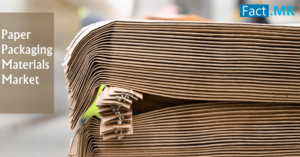Global Paper Packaging Materials Market to Reach US$ 465 Billion by 2032, Driven by 6% CAGR
Paper packaging offers a versatile and cost-effective solution for storing, transporting, and preserving a wide range of products. It can be easily customized to meet customer needs and product-specific requirements. Compared to other types of packaging, paper packaging provides several key benefits, including being lightweight, biodegradable, and recyclable.
The paper packaging materials market is being propelled by strict regulations from environmental protection agencies and increasing consumer awareness of sustainable packaging choices. The growing global population is driving demand for affordable packaging alternatives, such as bags, pouches, and cellulose-based materials.
A variety of end-use applications now call for environmentally safe and sustainable packaging materials as a result of recent breakthroughs in the packaging sector. This is a significant aspect influencing the development of the market for paper packaging materials.
Key Takeaways from Market Study:
- The global paper packaging materials market is valued at US$ 260 billion in 2022.
- Market in Canada is projected to progress at a CAGR of 5.3% over the forecast period (2022-2032).
- Sales of paper bags & sacks are anticipated to expand at a CAGR of 5.7% from 2022 to 2032.
- Market in Germany is set to evolve at a CAGR of 5.5% through 2032.
Paper Packaging Materials Gaining Huge Popularity:
Growing Demand for Sustainable Packaging – One of the primary reasons for the rising popularity of paper packaging materials is the global shift towards sustainability. With increasing concerns about environmental degradation, consumers and industries are seeking alternatives to traditional which is non-biodegradable and harmful to ecosystems.
Biodegradability and Recycling – The biodegradable nature of paper packaging is another key factor behind its growing popularity. Unlike plastic, which can take centuries to break down, paper decomposes naturally, reducing the long-term environmental impact. In addition, paper packaging is easily recyclable, making it an important component in the circular economy, where materials are reused and repurposed to minimize waste.
Lightweight and Cost-Effective -In addition to its environmental benefits, paper packaging is lightweight, which makes it more economical for shipping and transportation. Reduced shipping costs are a significant advantage for businesses looking to optimize logistics without sacrificing sustainability. Furthermore, the relatively low cost of paper packaging materials compared to other sustainable alternatives makes it a cost-effective option for businesses looking to balance environmental responsibility with operational efficiency.
Rising Consumer Awareness and Preference– Today’s consumers are more environmentally conscious than ever before, and their purchasing decisions are increasingly influenced by the sustainability practices of brands. This has led to a growing preference for products packaged in eco-friendly materials, such as paper. Brands that adopt paper packaging not only appeal to this environmentally aware consumer base but also enhance their brand image as socially responsible and sustainable.
Innovations in Paper Packaging Technology-Technological advancements in paper packaging have significantly enhanced its functionality and broadened its application across various sectors. For example, innovations like liquid packaging cartons and more durable paper materials have made paper packaging more suitable for items that require leak-proof or moisture-resistant properties. These advancements are making paper packaging more competitive with other forms of packaging, such as plastic and glass, while still maintaining its eco-friendly appeal.


Comments are closed.